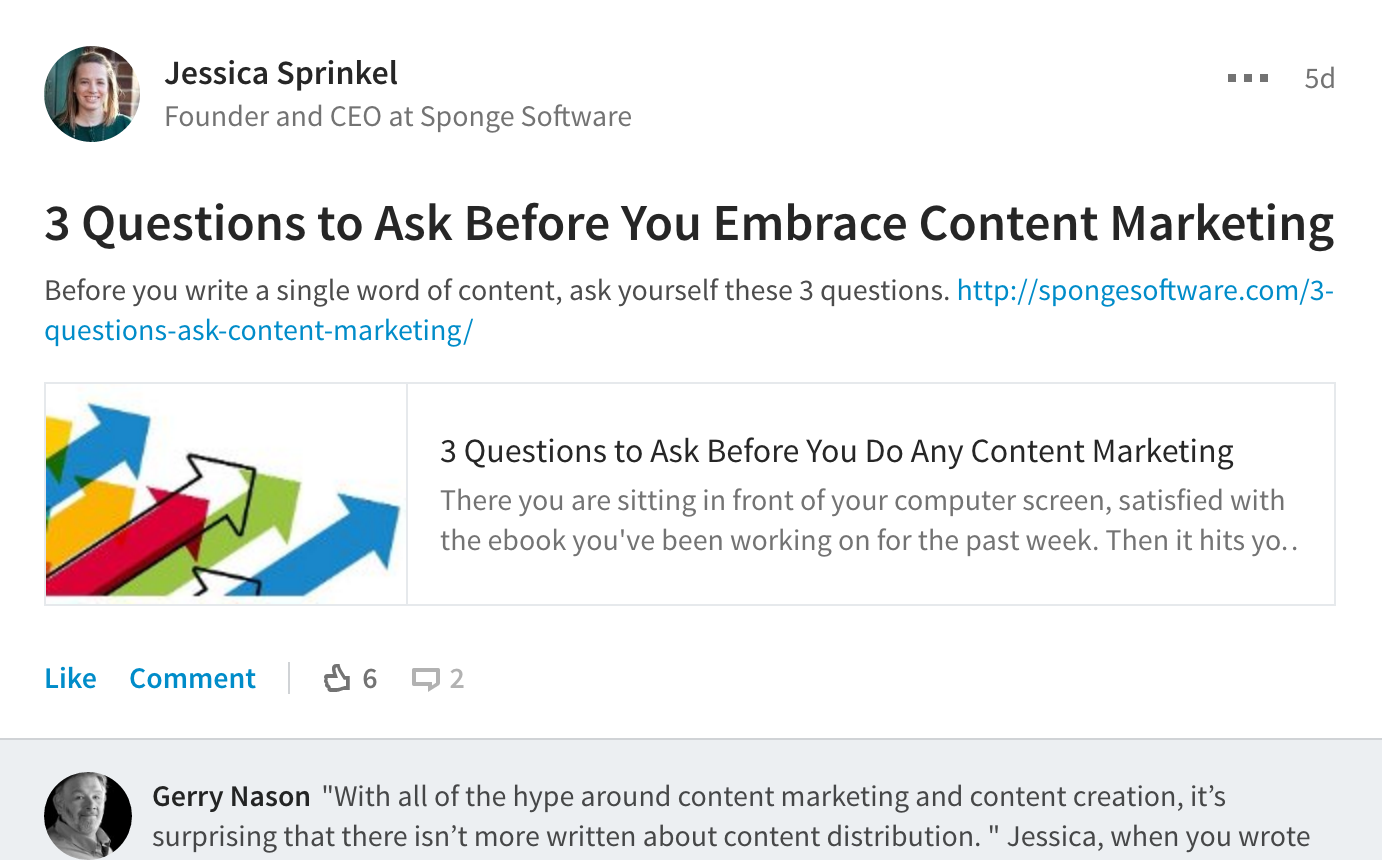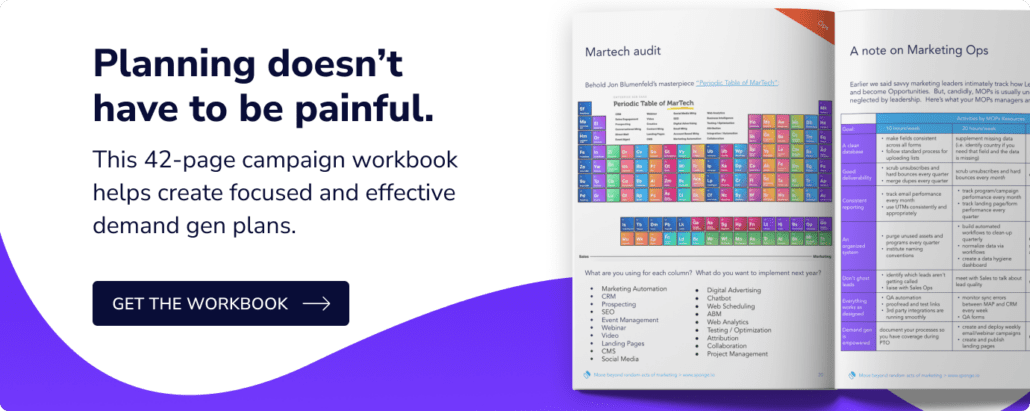If you write it, they… won’t come.
Despite your hard work in creating helpful, engaging, and visually stunning content, you probably haven’t spent enough time thinking through your content marketing distribution strategy. With all of the hype around content marketing and content creation, it’s surprising that there isn’t more written about content distribution. In this post, I’m going to assume you’ve already written some great content, and now you need to put it to work. We’ll discuss how to create a repeatable content marketing distribution strategy so you can get the most out of every asset, every time.
>> Related: A Guide to The Buyer’s Journey <<
A Note on Content Marketing Distribution
Before we get into it, I want to be clear that this isn’t a giant list of places to dump your content. In my experience, simply copy/pasting your content onto 20 sites without any thought as to how you’re helping the community is a waste of time for both you and your prospects. I call this kind of behavior “content spamming” – and in some ways it’s even more annoying than unsolicited email because there’s no way to unsubscribe.
How do you share your content far and wide without becoming a spammer? By making every post uniquely relevant to each audience with which you share it. Remember the cardinal rule of content marketing: it’s all about them. So whether you’re sharing content with a single influencer or a group of 10,000 people, don’t just copy/paste a link to your blog post or landing page. Tell them why they should care about what you have to say by relating it to something they’re already interested in.
Before you start distributing your content, brainstorm a few different angles to drive relevance with each audience you’re targeting. Ask yourself:
- Why would someone care to read it?
- Is it related to something they recently wrote/read about?
- Does it help them do their job better?
- Can you relate it something going on in pop culture?
You want to find a few different “hooks” to generate interest in your content vs. lazy, impersonal links. Focus on them, be creative/funny/provocative, and by all means act like a human being (no robots, please).
Content Marketing Distribution Strategy Basics
Once you have your angles, or hooks, you’re ready to start distributing content. Below are a few basic tactics to get you going:
Blog
Plan for one post per angle. A lot of people do one post per content asset, but this is bad for two reasons: 1) that post ends up being a glorified infomercial for your new asset (not necessarily bad, but it’s easy to get lazy, aka not helpful), and 2) if you only do one post for each asset, your promotion cycle will be very short. You’ve just spent a lot of time and resources writing a kickass ebook – give it the promotion it deserves by setting up a schedule that lasts at least 3 months (by the way, once you start thinking about angles for each new asset, I bet you’ll come up with new ideas for premium content, so the whole thing will become self-perpetuating). For each blog post, remember to utilize social share buttons, in-text link ads to promote the gated content asset, and a visual call to action at the end each post.
Social
Plan 10-20 social posts across all your social networks over the next 3 months. Remember to test different times of day, formats (question, listicles, key quote, direct). Beyond posting to your page, you can also leverage Groups. Be selective with the groups you post to (don’t want to become a spammer), but these can really help drive traffic and conversation around your new asset.


Also be sure to leverage your subject matter experts/influencers! Send an inMail/DM to key influencers alerting them to your new asset. You can use a tool like BuzzSumo to find people who have recently posted about the topic you’re writing about. Then you can do two things: 1) go to their posts and post a relevant comment (remember it’s ABOUT THEM) and link to your new post/asset, and 2) reach out to them directly using your most relevant angle.
Content Syndication
For the purposes of this post, I’ll tackle free content syndication resources, including Medium, industry-specific sites, and mass media publications, but for sure there will be many paid options as well, depending on your target audience. First, if you aren’t using LinkedIn, do not walk – run – to start cross-posting your blog posts on LinkedIn. I’ve also found some great success cross-posting with the disclaimer at the top/bottom along the lines of, “This post was originally published on the Sponge.io blog.” This has two benefits: 1) you’re tapping into LinkedIn’s audience which is likely much larger than your subscriber list, and 2) by sharing it as a Post as opposed to an Update on LinkedIn, the article will permanently live in your LinkedIn profile, so anyone looking at your profile will be exposed to this content from now on.


While I haven’t tested it much yet, I know a few colleagues that are building a following on Medium, and use it regularly in much the same way as LinkedIn. It seems to be a slower burn than LinkedIn (where I see a big spike within the first 48 hours, then a slow decline), but could be a good option if you put some work into growing your subscribers and are able to get featured. See this post on how to hack getting featured on Medium.
Depending on your industry, there will also be a bunch of blogs/news sites/other communities that allow you to syndicate your content. For example, at Sponge.io we target demand generation marketers, so relevant sites include the MOZ blog, Marketo blog, and inbound.org. We write guest articles for some sites, and cross-post articles on other sites. It really depends on the publication, so spend some time getting to know the relevant sites and how they leverage third party content.
Finally, for mass appeal articles, don’t be afraid to post to Huffington Post, Mashable, etc. Just like all editors, they’re often desperate for great content and many are really enthusiastic about new authors. I became a HuffPo writer after cold-emailing Arianna Huffington, who put me in touch with someone on her team. Now I can post on Huffington Post whenever I want and have my content seen by hundreds, thousands, even millions of people. Bottom line: don’t be shy about asking to become a writer – just make sure you can prove you’re writing quality stuff that’s relevant to their audience.
At long last email – because you know I’m all about that (data)base. Without a doubt, email will be your #1 source of traffic for content, so it should be one of your top priorities to grow your subscriber list. If you’re truly sharing educational stuff (read: not self-serving promotional stuff), definitely send at least one email per asset, potentially multiple emails to different segments of your database utilizing the different angles you brainstormed. You can also leverage new content assets in newsletter-ish roundups as well as email series. I’ve had a lot of success serializing content via email (I got this idea from Unbounce’s 7-day Landing Page Optimization ecourse). For example, let’s say we wrote an ebook on based on this blog post, and then we wanted to turn it into an email series. I might set up an email series like this:
- Does Content Distribution Work? (key is to make it uniquely relevant to each audience)
- Content Distribution Strategy: Blogging Basics (how to use your blog to drive traffic)
- How to Leverage Social to Promote Your Content (sample 3-month schedule)
- Are You Using LinkedIn Pulse for Content Distribution? (how-to guide)
- A Content Marketer’s Guide to Using Medium (in-depth case study)
- Get Featured on Huffington Post without a PR Agency (how-to guide)
- Content Marketing + Email: BFFs or Frenemies? (role of email using industry stats)
Just like that, I’ve turned one post into a seven-email series. This is a great tactic that requires very little work, and enables you to dive deep into topics you know are relevant to your target audience and establish your thought leadership. It’s also a great way to kickstart sales cycles – I usually end my emails with one of two things: 1) strong CTA to download premium content, or 2) reply with their thoughts/questions. The latter approach lends itself really well to people responding along the lines of, “Hey, this is really interesting – we’re actually experimenting with Medium right now but not sure how to measure the effectiveness of that channel.” To which you can respond with information about how your product/service helps them solve that problem. It’s sneaky simple.
Header image via Giphy





